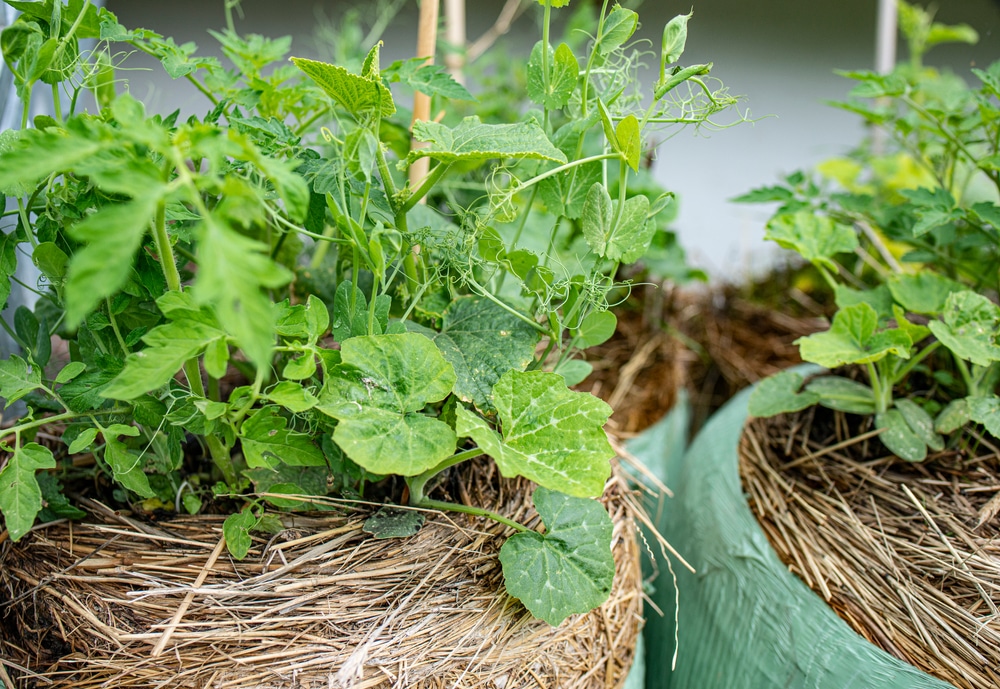Growing tomatoes in straw bales may sound out of this world, but there are some benefits to be had instead of going the regular route. If you’re wondering, can you grow tomatoes in straw bales? We’ll answer it below.
Can You Grow Tomatoes in a Straw Bale?
Disbelief aside, the answer is a definite yes. You can grow tomatoes, either the determinate or the indeterminate kind, with moderate success when you use a straw bale as the tomato’s planting medium.
However, planting tomatoes in a straw bale is not that simple. You will need to do a bit of preparation to get the bales ready, including buying them, moving them to the right location, and watering the material to make them conducive for tomato plants.
Growing your tomatoes in straw bales can give you several advantages over traditional soil. For one, straw is an organic material and will break down and decompose over time.
After planting tomatoes, you can use what’s left over as compost for your other plants. Two, it will be easier to prepare bales than digging up and weeding the ground. Lastly, you’ll have a movable and sterile medium for your tomatoes and have a reduced chance of working with poor-draining or diseased soil.
If the idea of growing tomatoes in straw bales still sounds appealing to you, here’s a step-by-step guide you can follow.
How to Grow Tomatoes in Straw Bales
Buy and Select the Right Type
The first thing you should do is find straw bales you can buy. They’re mostly available at garden centers, general goods, and farming supply shops, among others.
It’s worth noting that bales can be heavy, and you should pick the site where you’ll plant tomatoes beforehand so you won’t have to move them again. Keep in mind that tomatoes need a spot that gets full sunlight in order to grow healthy and produce lots of fruit.
Hay bales should be avoided if possible so you won’t have to deal with weeds and grass later on. Good options include wheat straw, buckwheat, or alfalfa.
Prepare the Straw Bale for Planting
Your straw bales will need to be prepared before you can plant your tomatoes. It’s recommended that you do this two to three weeks before you transplant your tomatoes outdoors to prevent delays.
Water and soak your bales thoroughly to activate the decomposition process. You can use a garden hose or a big watering can, constantly pouring water on it for around 5 to 10 minutes. Keep a daily watering schedule until you’re ready to transplant your tomato seedlings.
You can also add fertilizer during the last week of watering. A nitrogen-rich product, such as a balanced pellet fertilizer, fish meal, or blood meal works best for tomatoes.
Sow or Transplant Your Tomatoes
Transplanting should be done when all risk of frost has passed and the outdoor temperature does not dip below 60 degrees F. You can start tomato seeds indoors about 4-6 weeks before the last frost date so you can get a nice head start.
Make small gaps at the surface, then carefully put the tomato seedlings in. Surround the roots with quality potting soil, ensuring that the plants are established and sitting solidly on the straw bale. Add more soil to stabilize, then sprinkle with water and allow the tomatoes to settle.
The ideal number of tomatoes per straw bale is two. After planting, you can set up a support system in the form of stakes, trellises, or cages to support the thin vines and hold up the fruits.
Care and Growing Your Tomatoes
Growing tomatoes in a straw bale will more or less have the same requirements. You will need a spot that gets full sunshine and keep the soil, or in this case, the bales, constantly moist. You may need to water more since straw dries out faster and is more permeable than regular soil, but this can easily be fixed with a soaker hose or drip irrigation.
When feeding your tomatoes, it’s best to sprinkle or spray water instead of outright watering the bales. The nutrients may just pass through instead of staying in the straw and getting absorbed by the tomatoes. At the end of the growing season, compost the rest of the leftover materials.


